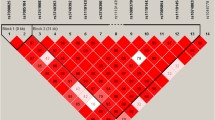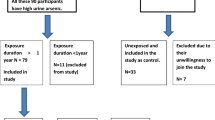Abstract
A total of 2,402 cases of arsenic-related skin lesions (as of 2002) in a few villages of China’s Southwest Guizhou Autonomous Prefecture represent a unique case of endemic arseniasis related with indoor combustion of high arsenic coal. A significant difference of skin lesion prevalence was observed between two clans of different ethnicities (Hmong and Han) in one of the hyperendemic villages in this prefecture. This study was focused on a possible involvement of GST T1 and M1 polymorphisms in risk modulation of skin lesions and in the body burden of As in this unique case of As exposure. GST T1 and M1 polymorphisms were genotyped by an allele-specific PCR-based procedure. Total As contents in hair and urine samples as well as environmental samples of the homes of the two ethnic clans were analyzed. No significant deviations in the population frequencies of GST T1 and M1 0/0 genotypes or their combination were recorded between diagnosed skin lesion patients and asymptomatic individuals in both clans. Significantly higher As contents in hair and urine were observed in GSTM1 0/0 carriers, not in GSTT1 0/0 carriers. After stratified by ethnicity and gender, a statistically significant association of the GSTM1 0/0 genotype and higher As content in hair was only confirmed in the subgroups of ethnic Han clan members and all male villagers, not in ethnic Hmong clan members or in females. GST T1 and M1 homozygous deletions were not associated with an increased susceptibility to skin lesions in long-term exposure to indoor combustion of high As coal. The polymorphic status at the locus of GSTM1 might modulate individual’s body burden of total As in some Chinese ethnic groups.
Similar content being viewed by others
References
Bolt HM, Thier R (2006) Relevance of the deletion polymorphisms of the glutathione S-transferases GSTT1 and GSTM1 in pharmacology and toxicology. Curr Drug Metab 7:613–628
Chiou HY, Hsueh YM, Hsieh LL, Hsu LI, Hsu YH, Hsieh FI et al (1997) Arsenic methylation capacity, body retention, and null genotypes of glutathione S-transferase M1 and T1 among current arsenic-exposed residents in Taiwan. Mutat Res 386:197–207
Ding ZH, Zheng BS, Long JP, Belkin HE, Finkelman RB, Chen CG et al (2001) Geological and geochemical characterities of high arsenic coal from endemic arsenosis area in southwestern Guizhou Province, China. Appl Geochem 16:1353–1360
Ghosh P, Basu A, Mahata J, Basu S, Sengupta M, Das JK et al (2006) Cytogenetic damage and genetic variants in the individuals susceptible to arsenic-induced cancer through drinking water. Int J Cancer 118:2470–2478
Hayakawa T, Kobayashi Y, Cui X, Hirano S (2005) A new metabolic pathway of arsenite: arsenic–glutathione complexes are substrates for human arsenic methyltransferase Cyt19. Arch Toxicol 79:183–191
Jin Y, Liang C, He G, Cao J (2003) Study on distribution of endemic arseniasis in China. Wei Sheng Yan Jiu (J Hyg Res) 32:519–540 (in Chinese)
Kiffmeyer WR, Langer E, Davies SM, Envall J, Robison LL, Ross JA (2004) Genetic polymorphisms in the Hmong population: implications for cancer etiology and survival. Cancer 100:411–417
Kile ML, Houseman EA, Rodrigues E, Smith TJ, Quamruzzaman Q, Rahman M et al (2005) Toenail arsenic concentrations, GSTT1 gene polymorphisms, and arsenic exposure from drinking water. Cancer Epidemiol Biomarkers Prev 14:2419–2426
Lin GF, Chen JG, Zhou YS, Shen JH (2003) Family aggregation of chronic arsenic poisoning associated with indoor burning of high arsenic coal. Toxicology 191:19 (abstract)
Lin GF, Du H, Chen JG, Lu HQ, Guo WC, Meng H et al (2006) Arsenic-related skin lesions and glutathione S-transferase P1 A1578G (Ile105Val) polymorphism in two ethnic clans exposed to indoor combustion of high arsenic coal in one village. Pharmacogenet Genomics 16:863–871
Liu J, Zheng BS, Aposhian HV (2002) Chronic arsenic poisoning from burning high-arsenic coal in Guizhou, China. Environ Health Perspect 110:119–122
Ma QW, Lin GF, Chen JG, Shen JH (2002) Polymorphism of glutathione S-transferase T1, M1 and P1 genes in Shanghai population: occupational and non-occupational bladder cancer patient groups. Biomed Environ Sci 15:253–260
Parl FF (2005) Glutathione S-transferase genotypes and cancer risk. Cancer Lett 221:123–129
Shen J, Lin G, Yuan W, Tan J, Bolt HM, Thier R (1998) Glutathione transferase T1 and M1 genotype polymorphism in the normal population of Shanghai. Arch Toxicol 72:456–458
Vahter M (2001) Genetic polymorphism in the biotransformation of inorganic arsenic and its role in toxicity. Toxicol Lett 112–113:209–217
Wang G, Zhang L, Li Q (2006) Genetic polymorphisms of GSTT1, GSTM1, and NQO1 genes and diabetes mellitus risk in Chinese population. Biochem Biophys Res Commun 341:310–313
WHO (World Health Organization) (2004) Guideline for drinking water, 3rd edn. Chap 8. Chemical aspect. WHO, Geneva, p 42. See:http://www.who.int/water_sanitation_health/dwq/gdwq3/en
Zheng BS, Wang BB, Ding ZH, Zhou DX, Zhou YS, Zhou C, et al. (2005) Endemic arsenosis caused by indoor combustion of high-As coal in Guizhou Province, P.R. China. Environ Geochem Health 27:521–552
Zhong SL, Zhou S, Chen X, Huang M (2006) Rapid determination of common mutations in glutathione S-transferase gene by PCR-based methods in healthy Chinese. Clin Chim Acta 364:205–208
Zhou DX, Zhou YS, Zhou C, Jin DX, Peng JH, Luo ML et al (1994) Correlation of total arsenic intake and incidence of arsenic poisoning in coal type endemic area. Chin J Endemic Dis 13:215–218 (in Chinese)
Zhou DX, Liu DN, Zhu ZL, Li BL, Jin DX, Zhou YS et al (1997) Investigation of chronic arsenic poisoning caused by high arsenic coal pollution. Chin J Prev Med 27:147–150 (in Chinese)
Acknowledgments
This work was supported by Chinese State’s Strategic Basic Research Project (973, grant: 2002CB512900)
Author information
Authors and Affiliations
Corresponding author
Rights and permissions
About this article
Cite this article
Lin, Gf., Du, H., Chen, Jg. et al. Glutathione S-transferases M1 and T1 polymorphisms and arsenic content in hair and urine in two ethnic clans exposed to indoor combustion of high arsenic coal in Southwest Guizhou, China . Arch Toxicol 81, 545–551 (2007). https://doi.org/10.1007/s00204-007-0187-4
Received:
Accepted:
Published:
Issue Date:
DOI: https://doi.org/10.1007/s00204-007-0187-4




